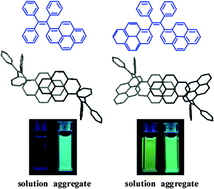Pyrene-substituted ethenes: aggregation-enhanced excimer emission and highly efficient electroluminescence†
Abstract

* Corresponding authors
a
Department of Chemistry, Institute of Molecular Functional Materials, The Hong Kong University of Science & Technology (HKUST), Clear Water Bay, Kowloon, Hong Kong, China
E-mail:
tangbenz@ust.hk
b College of Material, Chemistry and Chemical Engineering, Hangzhou Normal University, Hangzhou, China
c Center for Display Research, HKUST, Kowloon, Hong Kong, China
d State Key Laboratory of Supramolecular Structure and Materials, Jilin University, Changchun, China
e Department of Polymer Science and Engineering, Zhejiang University, Hangzhou, China

 Please wait while we load your content...
Something went wrong. Try again?
Please wait while we load your content...
Something went wrong. Try again?
Z. Zhao, S. Chen, J. W. Y. Lam, Z. Wang, P. Lu, F. Mahtab, H. H. Y. Sung, I. D. Williams, Y. Ma, H. S. Kwok and B. Z. Tang, J. Mater. Chem., 2011, 21, 7210 DOI: 10.1039/C0JM04449K
To request permission to reproduce material from this article, please go to the Copyright Clearance Center request page.
If you are an author contributing to an RSC publication, you do not need to request permission provided correct acknowledgement is given.
If you are the author of this article, you do not need to request permission to reproduce figures and diagrams provided correct acknowledgement is given. If you want to reproduce the whole article in a third-party publication (excluding your thesis/dissertation for which permission is not required) please go to the Copyright Clearance Center request page.
Read more about how to correctly acknowledge RSC content.
 Fetching data from CrossRef.
Fetching data from CrossRef.
This may take some time to load.
Loading related content
